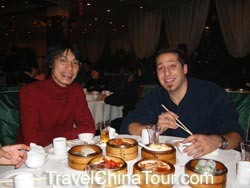In the 1st
part, we covered Szechuan cuisine and Shangdong Cuisine.
We'll briefly talk about the other six remaining famous
Chinese Cuisines.
China Guangdong (Cantonese) Cuisine
Cantonese cooking is light and fresh tasting, and Cantonese
restaurants are widely spread throughout the world, so it's
a cooking style that westerners are familiar with. Guangdong
food includes delicacies of Guangdong, Chaozhou, Hainan,
and Dongjiang.
The most important aspect of Guangdong cuisine is freshness.
Cantonese cooking uses cooking methods such as stir frying,
grilling, stewing, soups, deep frying, roasting, and braising.
A Guangdong specialty is roasted suckling pig - coated inside
with fermented tofu, sesame paste, garlic sugar, and then
roasted until the skin is golden red in color. The skin
of the roasted pig are crisp and crunchy, while the meat
is tender and soft.
Typical menu items include steamed fish, shark fin soup,
roasted piglet, and dim sum. In western countries, dim sum
is widely served in Chinese restaurants - its a style of
eating that I enjoy very much. Dim sum involves picking
and choosing from a variety of freshly cooked dishes either
from a cart being pushed around the restaurant, or ordering
from a dim sum menu (this depends on the restaurant).
Dim sum dishes are typically steamed, with some stir frying
and deep frying. They come in a small saucer in a small
bamboo steamer usually about 6 to 7 inches in diameter.
Dim sum typically serve seafood, chicken, pork and beef.
See picture below:

Sitting across from me: my brother in law and my Canadian
friend who went on a trip to China with me. On our table
are several bamboo steamers filled with dim sum dishes.
China Huaiyang Cuisine (Jiangsu Style)
The origins of Huaiyang cuisine can be traced back to about
300 BC. Huaiyang cuisine originated in Yangzhou. The most
important patron of Huaiyang Cuisine in history was emperor
Zhu YuanZhang (1328 - 1398). He was the founding emperor
of the Ming Dynasty. He enjoyed Huaiyang (Jiangsu) cooking
so much that he designated it as the imperial court kitchen
in Nanjing, which was the first capital of the Ming dynasty.
When the capital was moved from Nanjing to Beijing by the
3rd Ming emperor Yongle (1360 - 1424), he also brought the
Huaiyang chefs and Cuisine with him to Beijing.
Huaiyang cuisine is popular in the lower regions of the
Yangtze River, and its specialties are light flavored and
fresh tasting. Jiangsu style cooking is also well known
for its carving techniques, especially on melon carvings.
Fujian China Cuisine
Fujian cooking is a combination of Fuzhou, QuanZhou and
Xiamen cuisine styles. Fujian cuisine emphasized seafood
such as fish and shrimp. Its coastal areas product 160 some
varieties of fish and 90 kinds of turtles and shellfish.
These seafood products are widely used in Fujian cuisine.
It was during the mid of Qing dynasty when Fujian cuisine
gradually spread through other parts of china.
Since a majority of the dishes are made using seafood,
cutting is a very important aspect of the cooking process.
One of the most important dishes of Fujian cuisine is Buddha
Jumping Over the Wall - a name implying that the dish is
so delicious that a Buddha is jumping over the wall just
to get it. Other famous dishes include: Snow Chicken, and
Prawn with Dragon's Body and Phoenix Tail.
Hunan China Cooking
Hunan cuisine has a history of over 2,100 years. Hunan
province is located in southeastern China, along the middle
stretch of the Yantze River. Because of the humidity in
Hunan, its food is spicy, and consists of more than 4,000
dishes.
Hunan cuisine cooking methods use stir frying, deep frying,
steaming, simmering, stewing, and quick frying. Common Hunan
dishes include Dongan Chicken, Peppery Hot Chicken, stir
fried tripe silvers, duck web soup, lotus seed with rock
candy, and hot and spicy frog leg.
Zhejiang China Cuisine
Zhejiang cuisine is well known for its fresh, tender, and
fragrant dishes. Zhejiang cooking stresses the use of vegetables,
mushrooms and bamboo shoots. The fish and shrimp are usually
kept alive until cooked, so the food served are very fresh.
Zhejiang dishes come in a slightly sweet flavor and has
less of a salty taste. Emperor Qianlong of Qing dynasty
praised the Mandarin Fish topped with Sweet and Sour Tomato
Sauce as the best dish in the world. Other famous dishes
include West Lake Fish Steamed in Vinegar, and Braised shrimp
served with Longjing Tea.=
Anhui China Cooking
Anhui cuisine (Hui Cai) is also one of the eight famous
regional cuisines in China. Much of its cooking ingredients
come from the mountain regions such as the famous Huangshan
Mountain (Yellow Mountain). Anhui cuisine focus on the taste,
color and the temperature at which the dishes are cooked
at. Anhui food is slightly spicy and salty. Popular dishes
include stewed turtle with ham, Huangshan braised Pigeon,
Stewed Fish Belly, Steamed Stone Frog, and Bamboo shoots
Cooked with Sausage. Candied sugar and ham are often added
to dishes to improve its taste and aroma.
|